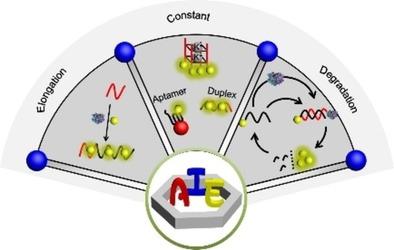当前位置:
X-MOL 学术
›
Chem. Asian J.
›
论文详情
Our official English website, www.x-mol.net, welcomes your feedback! (Note: you will need to create a separate account there.)
AIEgens/Nucleic Acid Nanostructures for Bioanalytical Applications
Chemistry - An Asian Journal ( IF 4.1 ) Pub Date : 2019-01-07 , DOI: 10.1002/asia.201801595 Xudong Wang 1 , Min Xu 2 , Kaixun Huang 1 , Xiaoding Lou 2 , Fan Xia 1, 2
Chemistry - An Asian Journal ( IF 4.1 ) Pub Date : 2019-01-07 , DOI: 10.1002/asia.201801595 Xudong Wang 1 , Min Xu 2 , Kaixun Huang 1 , Xiaoding Lou 2 , Fan Xia 1, 2
Affiliation

|
DNA occupies significant roles in life processes, which include encoding the sequences of proteins and accurately transferring genetic information from generation to generation. Recent discoveries have demonstrated that a variety of biological functions are correlated with DNA′s conformational transitions. The non‐B form has attained great attention among the diverse forms of DNA over the past several years. The main reason for this is that a large number of studies have shown that the non‐B form of DNA is associated with gross deletions, inversions, duplications, translocations as well as simple repeating sequences, which therefore causes human diseases. Consequently, the conformational transition of DNA between the B‐form and the non‐B form is important for biology. Conventional fluorescence probes based on the conformational transitions of DNA usually need a fluorophore and a quencher group, which suffers from the complex design of the structure and tedious synthetic procedures. Moreover, conventional fluorescence probes are subject to the aggregation‐caused quenching (ACQ) effect, which limits their application toward imaging and analyte detection. Fluorogens exhibiting aggregation‐induced emission (AIE) have attracted tremendous attention over the past decade. By taking advantage of this unique behavior, plenty of fluorescent switch‐on probes without the incorporation of fluorescent quenchers/fluorophore pairs have been widely developed as biosensors for imaging a variety of analytes. Herein, the recent progress in bioanalytical applications on the basis of aggregation‐induced emission luminogens (AIEgens)/nucleic acid nanostructures are presented and discussed.
中文翻译:

用于生物分析的AIEgens /核酸纳米结构
DNA在生命过程中起着重要作用,其中包括编码蛋白质序列并准确地一代又一代地传递遗传信息。最近的发现表明,多种生物学功能与DNA的构象转变有关。在过去的几年中,非B形式在DNA的各种形式中引起了极大的关注。造成这种情况的主要原因是,大量研究表明,DNA的非B形式与总体缺失,倒位,重复,易位以及简单的重复序列有关,从而导致人类疾病。因此,DNA在B型和非B型之间的构象转变对生物学很重要。基于DNA构象转变的常规荧光探针通常需要荧光团和淬灭基团,其结构设计复杂且合成程序繁琐。此外,常规的荧光探针会受到聚集引起的猝灭(ACQ)的影响,这限制了它们在成像和分析物检测中的应用。在过去的十年中,表现出聚集诱导排放(AIE)的氟化物引起了极大的关注。通过利用这种独特的行为,已经广泛开发了许多不引入荧光猝灭剂/荧光团对的荧光开关探针,作为用于对各种分析物进行成像的生物传感器。在此处,
更新日期:2019-01-07
中文翻译:

用于生物分析的AIEgens /核酸纳米结构
DNA在生命过程中起着重要作用,其中包括编码蛋白质序列并准确地一代又一代地传递遗传信息。最近的发现表明,多种生物学功能与DNA的构象转变有关。在过去的几年中,非B形式在DNA的各种形式中引起了极大的关注。造成这种情况的主要原因是,大量研究表明,DNA的非B形式与总体缺失,倒位,重复,易位以及简单的重复序列有关,从而导致人类疾病。因此,DNA在B型和非B型之间的构象转变对生物学很重要。基于DNA构象转变的常规荧光探针通常需要荧光团和淬灭基团,其结构设计复杂且合成程序繁琐。此外,常规的荧光探针会受到聚集引起的猝灭(ACQ)的影响,这限制了它们在成像和分析物检测中的应用。在过去的十年中,表现出聚集诱导排放(AIE)的氟化物引起了极大的关注。通过利用这种独特的行为,已经广泛开发了许多不引入荧光猝灭剂/荧光团对的荧光开关探针,作为用于对各种分析物进行成像的生物传感器。在此处,



























 京公网安备 11010802027423号
京公网安备 11010802027423号